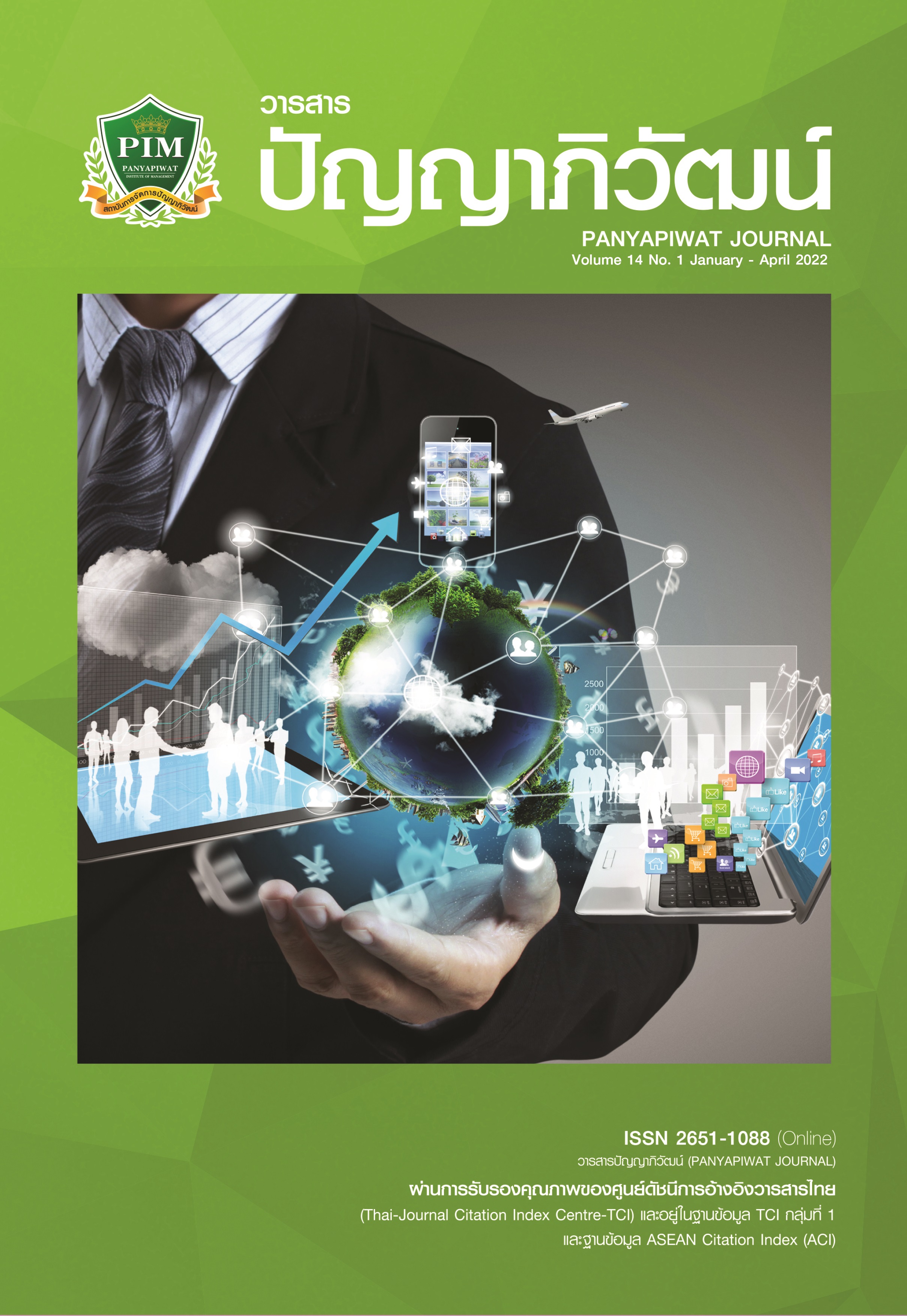ผลกระทบของคุณภาพบริการอิเล็กทรอนิกส์และความไว้วางใจต่อการรับรู้ประโยชน์ ในการซื้อสินค้าออนไลน์ในประเทศไทยผ่านช่องทางอิเล็กทรอนิกส์มาร์เก็ตเพลส
Main Article Content
บทคัดย่อ
การวิจัยนี้มีวัตถุประสงค์เพื่อศึกษาผลกระทบของคุณภาพบริการอิเล็กทรอนิกส์และความไว้วางใจที่มีต่อการรับรู้ประโยชน์ในการซื้อสินค้าออนไลน์ในประเทศไทยผ่านช่องทางอิเล็กทรอนิกส์มาร์เก็ตเพลสกลุ่มตัวอย่าง คือ ลูกค้าที่เคยซื้อสินค้าผ่านช่องทางอิเล็กทรอนิกส์มาร์เก็ตเพลสในประเทศไทย จำนวน 300 คน เก็บข้อมูลโดยใช้แบบสอบถามออนไลน์ ใช้วิธีการสุ่มตัวอย่างโดยไม่อาศัยหลักความน่าจะเป็นด้วยการสุ่มตัวอย่างแบบสะดวก สถิติที่ใช้ในการวิเคราะห์ข้อมูล ได้แก่ ค่าเฉลี่ย ค่าร้อยละ ค่าส่วนเบี่ยงเบนมาตรฐาน และใช้ตัวแบบสมการโครงสร้างในการวิเคราะห์และทดสอบสมมติฐานผลการวิจัยพบว่า ตัวแบบมีความสอดคล้องกับข้อมูลเชิงประจักษ์โดยมีค่าดัชนีชี้วัดต่าง ๆ ดังต่อไปนี้ CMIN/DF = 2.496, GFI = 0.924, NFI = 0.929, RFI = 0.910, IFI = 0.956, TLI = 0.944, CFI = 0.956 และ RMSEA = 0.072 ผลการทดสอบสมมติฐานพบว่า คุณภาพบริการเล็กทรอนิกส์มีอิทธิพลทั้งทางตรงและทางอ้อมต่อการรับรู้ประโยชน์ในการซื้อสินค้าออนไลน์ในประเทศไทยผ่านช่องทางอิเล็กทรอนิกส์มาร์เก็ตเพลส อย่างมีนัยสำคัญทางสถิติที่ระดับ 0.001 คุณภาพบริการอิเล็กทรอนิกส์มีอิทธิพลทางตรงต่อความไว้วางใจ อย่างมีนัยสำคัญทางสถิติที่ระดับ 0.001 และความไว้วางใจมีอิทธิพลต่อการรับรู้ประโยชน์ในการซื้อสินค้าออนไลน์ในประเทศไทยผ่านช่องทางอิเล็กทรอนิกส์มาร์เก็ตเพลส อย่างมีนัยสำคัญทางสถิติที่ระดับ 0.001 จากการวิจัยครั้งนี้ได้ข้อค้นพบที่สำคัญว่า คุณภาพบริการอิเล็กทรอนิกส์และความไว้วางใจเป็นปัจจัยที่สำคัญในการพัฒนาธุรกิจการพาณิชย์อิเล็กทรอนิกส์ ซึ่งส่งผลไปยังการรับรู้ประโยชน์ในการซื้อสินค้าออนไลน์ ทั้งนี้ผลจากงานวิจัยสามารถใช้เป็นตัวแบบสำหรับผู้ประกอบการพาณิชย์อิเล็กทรอนิกส์ในการกำหนดกลยุทธ์เพื่อให้เกิดข้อได้เปรียบทางการแข่งขันและการพัฒนาการให้บริการที่มีประสิทธิภาพสอดคล้องกับความต้องการของผู้บริโภคอันเป็นปัจจัยสู่ความสำเร็จของผู้ประกอบการพาณิชย์อิเล็กทรอนิกส์ในประเทศไทยได้
Article Details

อนุญาตภายใต้เงื่อนไข Creative Commons Attribution-NonCommercial-NoDerivatives 4.0 International License.
“ข้าพเจ้าและผู้เขียนร่วม (ถ้ามี) ขอรับรองว่า บทความที่เสนอมานี้ยังไม่เคยได้รับการตีพิมพ์และไม่ได้อยู่ระหว่างกระบวนการพิจารณาลงตีพิมพ์ในวารสารหรือแหล่งเผยแพร่อื่นใด ข้าพเจ้าและผู้เขียนร่วมยอมรับหลักเกณฑ์การพิจารณาต้นฉบับ ทั้งยินยอมให้กองบรรณาธิการมีสิทธิ์พิจารณาและตรวจแก้ต้นฉบับได้ตามที่เห็นสมควร พร้อมนี้ขอมอบลิขสิทธิ์บทความที่ได้รับการตีพิมพ์ให้แก่สถาบันการจัดการปัญญาภิวัฒน์หากมีการฟ้องร้องเรื่องการละเมิดลิขสิทธิ์เกี่ยวกับภาพ กราฟ ข้อความส่วนใดส่วนหนึ่งและ/หรือข้อคิดเห็นที่ปรากฏในบทความข้าพเจ้าและผู้เขียนร่วมยินยอมรับผิดชอบแต่เพียงฝ่ายเดียว”
เอกสารอ้างอิง
Akroush, M. N., & Al-Debei. M. M. (2015). An integrated model of factors affecting consumer attitudes towards online shopping. Business Process Management Journal, 21(6), 1353-1376.
Al-Debei, M. M., Akroush, M. N., & Ashouri, M. I. (2015). Consumer attitudes towards online shopping: The effects of trust, perceived benefits, and perceived web quality. Internet Research, 25(5), 707-733.
Arora, N., & Aggarwal, A. (2018). The role of perceived benefits in formation of online shopping attitude among women shoppers in India. South Asian Journal of Business Studies, 7(1), 91-110.
Barnes, S., & Vidgen, R. (2002). An integrative approach to the assessment of e-commerce quality. Journal of Electronic Commerce Research, 3(3), 114-127.
Bojang, I. (2017). Determinants of trust in B2C e-commerce and their relationship with consumer online trust: A case of Ekaterinburg, Russian Federation. Journal of Internet Banking and Commerce, 22(8), 1-59.
Butt, I., Tabassam, S., Chaudhry, G. N., & Nusair, K. (2016). Using technology acceptance model to study adoption of online shopping in an emerging economy. Journal of Internet Banking and Commerce, 21(2), 1-18.
Chou, S. W., & Hsu, C. S. (2016). Understanding online repurchase intention: Social exchange theory and shopping habit. Information Systems and e-Business Management, 14(1), 19-45.
Cronbach, L. J. (1990). Essentials of psychological testing (5th ed.). Harper & Row.
Easley, D. W. (2016). An exploratory study on perceived risk, benefits, and online buying behavior from a cross-cultural perspective [Doctoral dissertation]. Capella University.
Elbeltagi, I., & Agag, G. (2016). E-retailing ethics and its impact on customer satisfaction and repurchase intention. Internet Research, 26(1), 288-310.
Electronic Transactions Development Agency. (2014). 3 Years ETDA enabling digital economy. Electronic Transactions Development Agency.
Electronic Transactions Development Agency. (2015). Supporting documents for the 2015 e-commerce value survey report in Thailand. Electronic Transactions Development Agency.
Electronic Transactions Development Agency. (2017). Report of survey results of electronic commerce in Thailand in 2017. Electronic Transactions Development Agency.
Electronic Transactions Development Agency. (2018). Checklist to know about online trading. Electronic Transactions Development Agency.
Electronic Transactions Development Agency. (2020). Value of e-commerce survey in Thailand 2019. Electronic Transactions Development Agency.
Fang, J., Wen, C., George, B., & Prybutok, V. R. (2016). Consumer heterogeneity, perceived value and repurchase decision-making in online shopping: The role of gender, age, and shopping motives. Journal of Electronic Commerce Research, 17(2), 116-131.
Hair, J. F. A. H., Money, P., & Samouel, M. P. (2010). Multivariate data analysis: A global perspective (7th ed.). Pearson.
Joshi, D., & Achuthan, S. (2016). E-commerce buying behavior in India: The role of website features in e-loyalty. South Asian Journal of Management, 23(1), 56-88.
Kundu, S., & Datta, S. K. (2015). Impact of trust on the relationship of e-service quality and customer satisfaction. Euromed Journal of Business, 10(1), 21-46.
Marinkovic, V., & Kalinic, Z. (2017). Antecedents of customer satisfaction in mobile commerce: Exploring the moderating effect of customization. Online Information Review, 41(2), 138-154.
Mohamed, N., Hussein, R., Hidayah Ahmad Zamzuri, N., & Haghshenas, H. (2014). Insights into individual’s online shopping continuance intention. Industrial Management and Data Systems, 114(9), 1453-1476.
Obeidat, M. S. (2015). Consumer attitude toward online shopping in Jordan [Doctoral dissertation]. Wilmington University.
Palacios, S. (2016). Examining the effects of online shopping convenience, perceived value, and trust on customer loyalty [Doctoral dissertation]. New Mexico State University.
Parasuraman, A., Berry, L. L., & Zeithaml, V. A. (1991). Refinement and reassessment of the SERVQUAL scale. Journal of Retailing, 67(4), 420-450.
Parasuraman, A., Zeithaml, V. A., & Malhotra, A. (2005). E-S-QUAL a multiple-item scale for assessing electronic service quality. Journal of Service Research, 7(3), 213-233.
Phillips, B., Peak, D., & Prybutok, V. (2016). SNSQUAL: A social networking site quality model. The Quality Management Journal, 23(3), 19-36.
Positioning. (2021). Insight into the direction of e-commerce in 2020 that will become the “Breaking Point” of social media and e-marketplace. https://positioningmag.com/1282872
Roche, I. D. (2014). An empirical investigation of internet banking service quality, corporate image and the impact on customer satisfaction; with special reference to Sri Lankan banking sector. Journal of Internet Banking and Commerce, 19(2), 1-18.
Sinha, P., & Singh, S. (2016). E-retailing in developing economy: A study on consumers’ perceptions. Academy of Marketing Studies Journal, 20(3), 62-72.
Wolfinbarger, M., & Gilly, M. C. (2003). ETailQ: Dimensionalizing, measuring and predicting etail quality. Journal of Retailing, 79(3), 183-198.
Yoo, B., & Donthu, N. (2001). Developing a scale to measure the perceived quality of internet shopping sites (SITEQUAL). Quarterly Journal of Electronic Commerce, 2(1), 31-47.
Zhu, J., Muhammad Awais Shakir, G., & Cai, Y. (2018). Retailer-consumer sustainable business environment: How consumers’ perceived benefits are translated by the addition of new retail channels. Sustainability, 10(9), 1-22.


